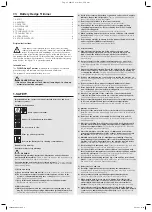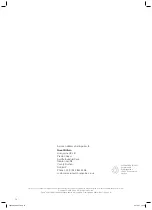
5
Page 2 width 2 mm less: 208 mm
e) Do not use a battery pack or tool that is damaged or modified.
Damaged or modified batteries may exhibit unpredictable behavior resulting
in fire, explosion or risk of injury.
f) Do not expose a battery pack or tool to fire or excessive temperature.
Exposure to fire or temperature above 130 °C may cause explosion.
g) Follow all charging instructions and do not charge the battery pack or
tool outside the temperature range specified in the instructions.
Charging improperly or at temperatures outside the specified range may
damage the battery and increase the risk of fire.
6) Service
a) Have your machine serviced by a qualified repair person using only
identical replacement parts. This will ensure that the safety of the machine
is maintained.
b) Never service damaged battery packs. Service of battery packs should
only be performed by the manufacturer or authorized service providers.
Hedge trimmer safety warnings
a) Keep all parts of the body away from the blade. Do not remove cut
material or hold material to be cut when blades are moving. Blades
continue to move after the switch is turned off. A moment of inattention while
operating the hedge trimmer may result in serious personal injury.
b) Carry the hedge trimmer by the handle with the blade stopped and
taking care not to operate any power switch. Proper carrying of the
hedge trimmer will decrease the risk of inadvertent starting and resultant per-
sonal injury from the blades.
c) When transporting or storing the hedge trimmer, always fit the blade
cover. Proper handling of the hedge trimmer will decrease the risk of personal
injury from the blades.
d) When clearing jammed material or servicing the unit, make sure all
power switches are off and the battery pack is removed or discon-
nected. Unexpected actuation of the hedge trimmer while clearing jammed
material or servicing may result in serious personal injury.
e) When clearing jammed material or servicing the unit, make sure all
power switches are off and the lock-off is in the locked position.
Unexpected actuation of the hedge trimmer while clearing jammed material
or servicing may result in serious personal injury.
f) Hold the hedge trimmer by insulated gripping surfaces only, because
the blade may contact hidden wiring.
Blades contacting a “live” wire may make exposed metal parts of the hedge
trimmer “live” and could give the operator an electric shock.
g) Keep all power cords and cables away from cutting area.
Power cords or cables may be hidden in hedges or bushes and can be
accidentally cut by the blade.
h) Do not use the hedge trimmer in bad weather conditions, especially
when there is a risk of lightning.
This decreases the risk of being struck by lightning.
Search hedges and bushes for hidden objects (e.g. wire fences and hidden
wires).
The use of a residual current device (RCD) with a trip current of 30 mA or less
is recommended.
Hold the hedge trimmer with both hands on both handles.
The hedge trimmer is intended for use when the user is standing on the ground
and not on a ladder or other unstable surface.
Additional safety warnings
Battery safety
Read all the safety and general instructions.
Failure to observe the safety and general instructions may result in electric shock,
fire and / or serious injury.
Store these instructions in a safe place. Only use the charger if you can fully
evaluate all functions and carry them out without restrictions, or if you have recei-
ved corresponding instructions.
v
Supervise children during use, cleaning and maintenance.
This will ensure that children do not play with the charger.
v
Charge only lithium-ion batteries of the POWER FOR ALL system type
PBA 18V with a capacity of 1.5 Ah or more (5 battery cells or more).
The battery voltage must match the battery charging voltage of the
charger. Do not charge any non rechargeable batteries.
Otherwise there is a risk of fire and explosion.
v
Do not expose the charger to rain or wet conditions.
Water entering a power tool will increase the risk of electric
shock.
v
Keep the charger clean. Dirt poses a risk of electric shock.
v
Always check the charger, cable and plug before use. Stop using the
charger if you discover any damage. Do not open the charger yourself,
and have it repaired only by a qualified specialist using only original
replacement parts.
Damaged chargers, cables and plugs increase the risk of electric shock.
v
Do not operate the charger on an easily ignited surface (e. g. paper,
textiles, etc.) or in a flammable environment.
There is a risk of fire due to the charger heating up during operation.
v
In order to avoid safety hazards, if the power supply cord needs to be repla-
ced, this must be done by FLYMO or by a customer service centre that is
authorised to repair FLYMO power tools.
v
Do not operate the product while it is charging.
Products sold in GB only: Your product is fitted with an BS 1363/A approved
electric plug with internal fuse (ASTA approved to BS 1362). If the plug is not sui-
table for your socket outlets, it should be cut off and an appropriate plug fitted in
its place by an authorised customer service agent. The replacement plug should
have the same fuse rating as the original plug. The severed plug must be dispo-
sed of to avoid a possible shock hazard and should never be inserted into a
mains socket elsewhere.
v
These safety warnings apply only for lithium-ion batteries of the
POWER FOR ALL system PBA 18V.
v
Only use the battery with products of the POWER FOR ALL system
manufacturers. This is the only way in which you can protect the battery
against dangerous overload.
v
Recharge only with the charger specified by the manufacturer.
A charger that is suitable for one type of battery pack may create a risk of fire
when used with another battery pack.
v
The battery is supplied partially charged.
To ensure full battery capacity, fully charge the battery in the charger before
using your power tool for the first time.
v
Keep battery packs out of the reach of children.
v
Do not open the battery. There is a risk of short-circuiting.
v
In case of damage and improper use of the battery, vapours may be
emitted. The battery can set alight or explode.
Ensure the area is well ventilated and seek medical attention should you expe-
rience any adverse effects. The vapours may irritate the respiratory system.
v
If used incorrectly or if the battery is damaged, flammable liquid may
be ejected from the battery. Contact with this liquid should be avoid-
ed. If contact accidentally occurs, rinse off with water. If the liquid
comes into contact with your eyes, seek additional medical attention.
Liquid ejected from the battery may cause irritation or burns.
v
If the battery is damaged liquid can be ejected and cover nearby sur-
faces. Check affected parts. Clean these parts or change them if necessary.
v
Do not short-circuit the battery pack. When the battery pack is not in
use, keep it away from other metal objects, like paper clips, coins,
keys, nails, screws or other small metal objects, that can make a con-
nection from one terminal to another.
Shorting the battery terminals together may cause burns or a fire.
v
The battery contacts can be hot after use. Be careful of the hot contacts
when removing the battery.
v
The battery can be damaged by pointed objects such as nails or
screwdrivers or by force applied externally. An internal short circuit may
occur, causing the battery to burn, smoke, explode or overheat.
v
Never service damaged battery packs. Service of battery packs should
only be performed by the manufacturer or authorized service providers.
v
Protect the battery against heat, e. g. against continuous intense
sunlight, fire, dirt, water and moisture.
There is a risk of explosion and short-circuiting.
v
Only operate and store the battery at an ambient temperature
between – 20 °C and + 50 °C.
Do not leave the battery in your car in the summer, for example.
At temperatures of < 0 °C some devices may experience a loss of power.
v
Only charge the battery at an ambient temperature which is between
0 °C and + 45 °C. Charging outside of this temperature range can increase
the risk of damage to the battery and pose a fire hazard.
v
After use, allow the battery to cool down for at least 30 minutes before
charging or storing.
Electrical safety
DANGER! Cardiac arrest!
This product makes an electromagnetic field while it operates. This field
may under some conditions interfere with active or passive medical
implants. To decrease the risk of conditions that can possibly injure or
kill, we recommend persons with medical implants to speak with their
physi cian and the medical implant manufacturer before you operate the
product.
Only use the battery product between – 10 °C and 40 °C.
Thoroughly inspect the area where the product is to be used and remove all
wires and other foreign objects.
In case of an unintended start (e. g. due to a welded switch) disconnect the bat-
tery immediately from device and let the product repaired by the FLYMO service.
Disconnect the product from the mains and disconnect the battery if the product
starts to vibrate abnormally. Check immediately. Excessive vibration can cause
injury.
Do not use the product near water.
Do not operate next to swimming pools or garden ponds.
Protect the electrical contacts of the battery from moisture.
Personal safety
DANGER! Risk of suffocation!
Small parts can be easily swallowed. There is also a risk that the poly-
bag can suffocate toddlers. Keep toddlers away when you assemble the
product.
Know how to stop the product quickly in an emergency.
32450-85.960.01.indd 5
32450-85.960.01.indd 5
06.10.21 10:48
06.10.21 10:48
Содержание EasiCut 450
Страница 11: ...11 32450 85 960 01 indd 11 32450 85 960 01 indd 11 06 10 21 10 48 06 10 21 10 48 ...
Страница 12: ...12 32450 85 960 01 indd 12 32450 85 960 01 indd 12 06 10 21 10 48 06 10 21 10 48 ...
Страница 13: ...13 32450 85 960 01 indd 13 32450 85 960 01 indd 13 06 10 21 10 48 06 10 21 10 48 ...
































